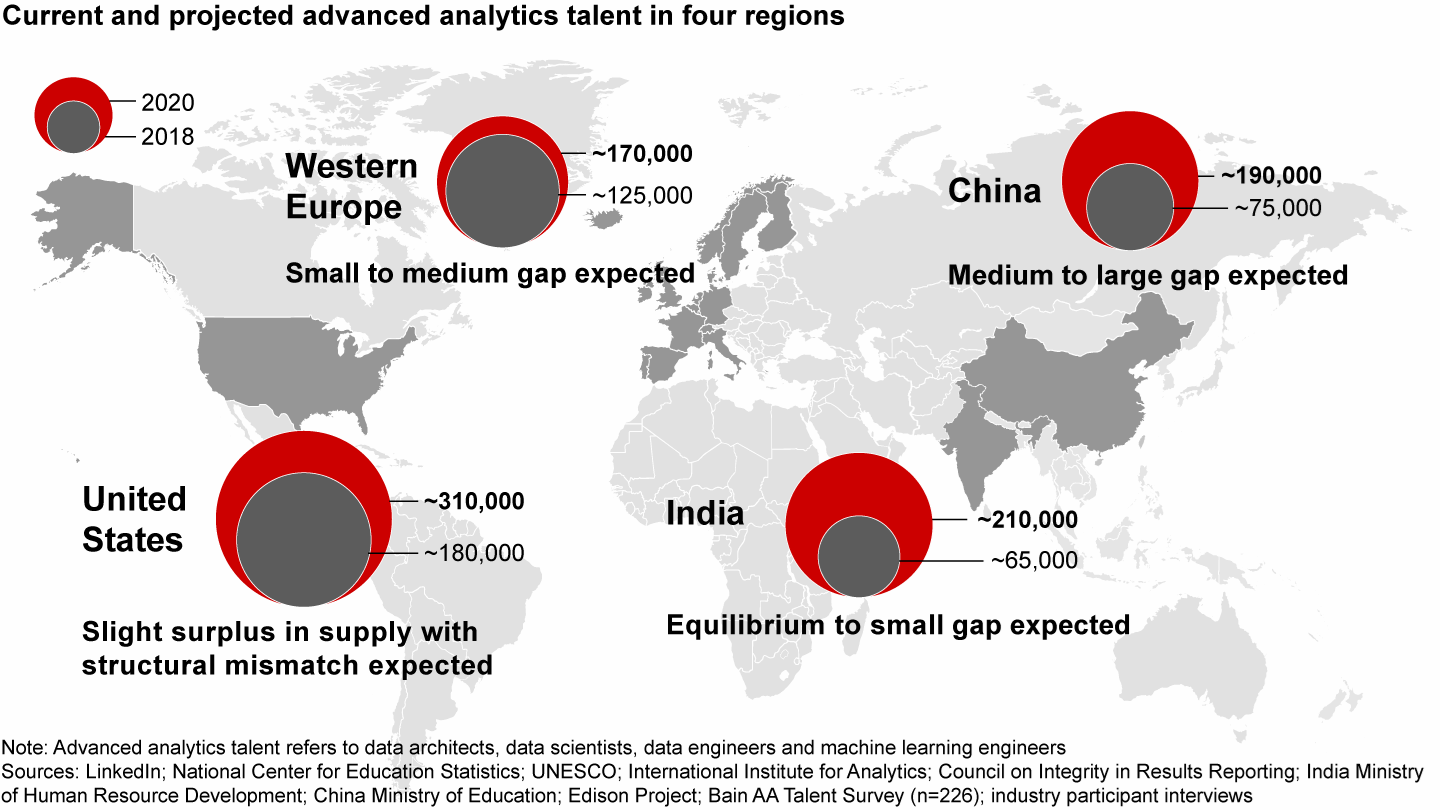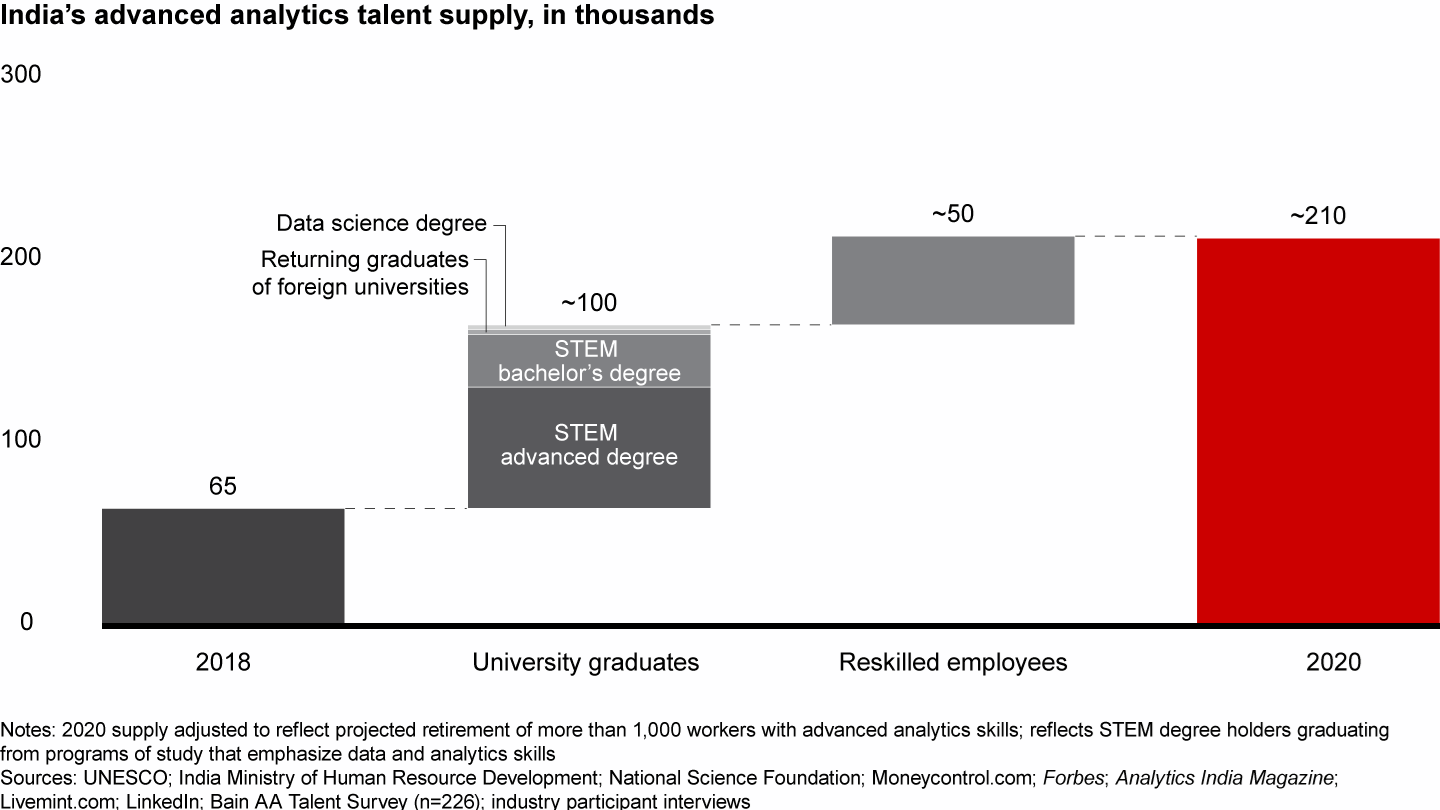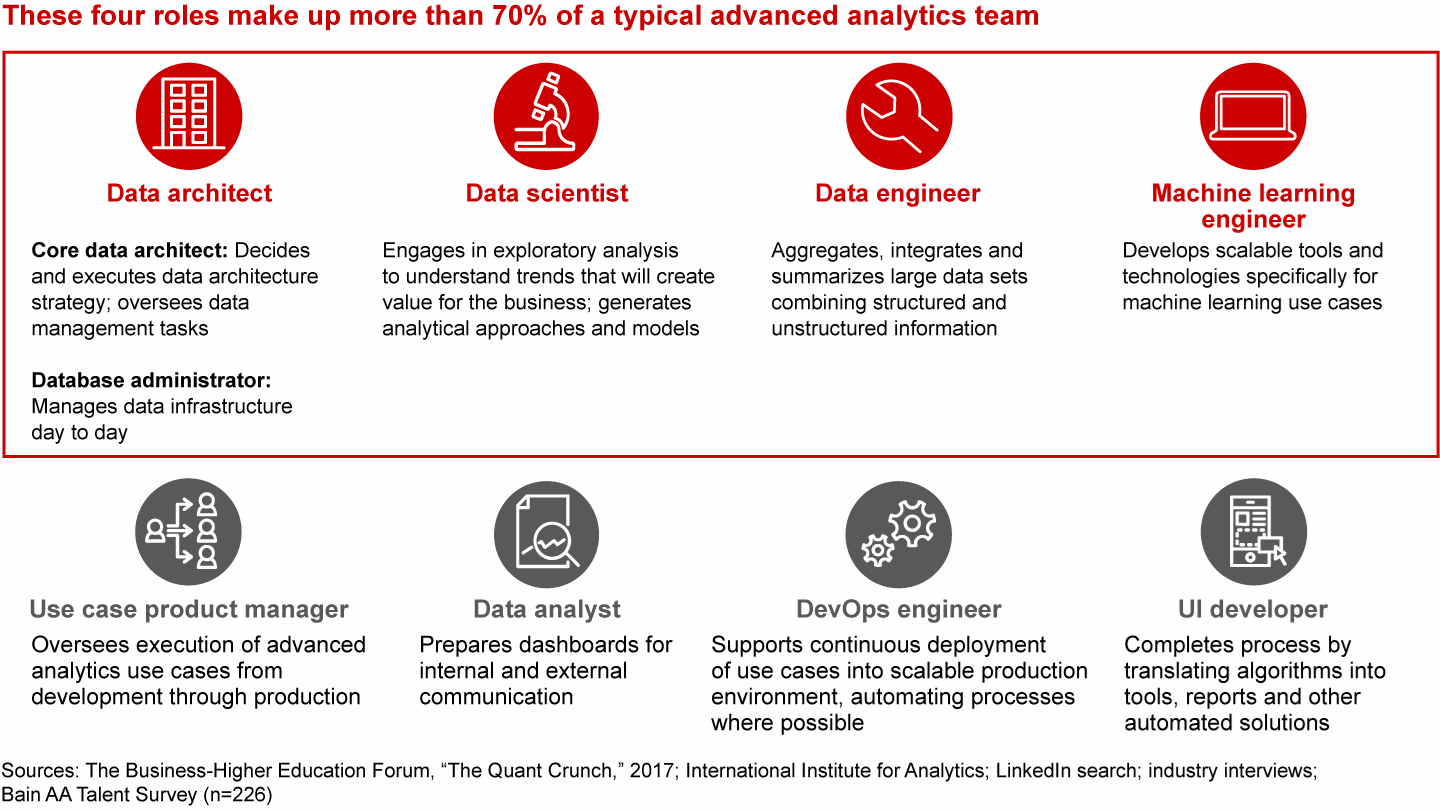Brief

At a Glance
- In the next two years, the global supply of advanced analytics talent will double, with India’s talent pool growing especially quickly.
- India has a unique opportunity to become a critical analytics hub for both domestic and global companies if educators, business and regulators solve some key challenges.
In certain eras, countries have dominated different fields. In the 1980s, Japan set the standard on manufacturing with total quality management. In the early 2000s, China became the place to beat for low-cost labor and high-quality manufacturing. India had its turn in the 1990s, when heavy investment in training programmers, especially in legacy systems ahead of Y2K systems upgrades, paved the way for the subcontinent to become an outsourcing giant.
Today we are in the midst of an explosion in data and analytics, and India has a chance to repeat as the hub of this fast-growing field.
Companies around the world have for years chased a limited supply of experienced advanced analytics professionals and new university graduates. But thanks to a recent and rapid pivot in traditional and nontraditional education, the global supply of advanced analytics talent is about to boom. By 2020, the worldwide advanced analytics talent pool is expected to reach 1 million people, double 2018 levels, according to Bain & Company research (see Figure 1). Much of that growth is coming from India, which Bain estimates will have three times as many candidates for advanced analytics work by 2020 as it did in 2018, expanding from 65,000 people to more than 200,000 in just two years.
Global advanced analytics talent is expected to double by 2020


Two trends are amplifying the talent pool in India. First, STEM undergraduate and graduate degree holders whose programs of study emphasize data and analytics skills continue to join the workforce in increasing numbers. Augmenting that is India’s deep existing ecosystem in information technology, especially in programming and systems integration. Outsourcing firms and the India IT centers of global corporations house many ideal candidates for learning new advanced analytics skills. These two sources have combined to make India a vital hub of analytics expertise and have fueled the early growth of its analytics outsourcing industry.
Up until now, the United States has been the leading source of advanced analytics–trained talent, but in the future, much of the growth will occur outside the US. China will also see strong growth, though not quite as fast as India’s.
Developing depth of expertise
For India to capitalize on this opportunity, the country must not only add to the ranks of those with advanced analytics skills, but also develop true depth of expertise.
That starts with fully investing in and funding the government’s efforts in this area. In 2015, the government established the Digital India program to help the country become a digitally empowered knowledge economy. The 2018–19 budget doubled Digital India’s allocation to more than $4 billion, and a new program focused on artificial intelligence was introduced. In a recent white paper, the National Institution for Transforming India cited AI’s potential to help address domestic challenges, including access to healthcare, agricultural output and efficiency of cities. Among the report’s recommendations is that government identify and promote jobs that may replace traditional IT work, such as computer vision engineers and cloud architects, and offer tax breaks for companies that retrain employees in advanced skills.
Venture capital investment will also strengthen India’s analytics ecosystem. A diverse group of VC and private equity investors has begun to fund the sector, ranging from investments in analytics service providers such as Mu Sigma and Fractal to data science and AI companies such as Locus and Vue.ai.
Universities can help by developing cross-disciplinary programs to train undergraduates for positions that require both analytics skills and business judgment. Seeding academic programs to graduate advanced degree holders, both master’s and doctoral, in the analytical sciences is especially critical, since it is in these programs that students really begin to work intensively with data and develop the most valuable skills.
In addition, companies will benefit from developing training programs to leverage existing technical talent, turning employees into analytic workers via industry programs and in-house corporate training (see Figure 2). According to Indian IT trade association Nasscom, more than 60% of organizations surveyed prefer to train and redeploy existing talent rather than hire skilled talent from outside.
New graduates and reskilled employees are expanding India’s analytics talent pool


India has one additional asset: its well-established centers of excellence in digital platforms and ecosystems in Hyderabad and Bangalore, home to Flipkart, Ola, Paytm and Swiggy, as well as Amazon.in, Google India and Facebook India. Government and academic partnerships with those companies could foster innovative approaches to developing academic programs, corporate training programs and even venture funding models such as public-private partnerships, co-op programs and internships.
Building an advanced analytics team
This ramp-up, however, won’t entirely solve the long-standing advanced analytics talent challenge. The most analytically mature sectors plan to grow their teams fastest, and employees are most interested in working for companies with well-established track records in analytics, our recent survey of more than 200 industry participants found.
Creative, flexible approaches for expanding the talent base include building centers of excellence for pools of hired analytics experts, as well as retraining capable existing employees and giving them access to automation tools. Importantly, rather than trying to do everything in-house, a tiered talent strategy should focus a core, in-house analytics team on strategic tasks while tapping offshore data hubs, third-party service firms and crowdsourcing for other work. Even the most sophisticated companies leverage a combination of internal and external supply chains for analytics capabilities.
What is the optimal blend of advanced analytics roles? How are teams best configured? The exact balance varies depending on the sector and maturity of a company’s analytics practice, but teams will draw from eight key roles (see Figure 3). With companies hiring to create balanced advanced analytics teams, certain skills are in higher demand.
An effective advanced analytics talent pool includes eight key roles


Breaking the talent bottleneck
The historical shortage of advanced analytics talent has caused many organizations to rely on a combination of internal and external expertise. This hybrid model benefits outsourcers in India and elsewhere, and it is a particularly good match for the breadth of advanced analytics expertise that will be needed in the future. A multilayered approach will continue to make more sense than full vertical integration for many companies. When possible, companies should develop critical mass internally in the most important aspects of advanced analytics, such as data-science team leadership and model development, and tap the external supply chain for less-critical skills, like tactical data management and model maintenance. Today, only 30% of companies are fully integrated in advanced analytics. The other 70% augment their internal skills with some combination of offshore outsourcing, freelancers, advanced analytics consultants and crowdsourcing.
Harnessing shadow analytics talent—that is, taking people currently walking the halls and helping them develop new analytical skills—has particular benefits. Existing employees already know the company, the industry and how to operate effectively across the organization. Many have the quantitative background to learn analytical skills, and nearly a quarter of Bain survey respondents report that their companies have implemented advanced analytics training programs.
According to Nasscom, Tata Consultancy Services has trained more than 292,000 of its employees on digital technologies. EXL, a global operations and analytics company based in the US with operations in India, has trained about 3,000 employees in analytics and another 1,000 in robotics. In addition to in-house programs, training options include free MOOCs—massive open online courses—and paid retraining programs.
Some companies with a good data science workbench and the right set of data engineering tools also use advanced analytics automation to enable people without strong coding skills to build models and engineer data. Of survey respondents currently using technologies to automate advanced analytics tasks, more than half say these technologies allow them to rapidly train existing staff to take on responsibilities of a data scientist or data engineer.
The opportunity in data security and privacy
Already an outsourcing mainstay, India has the potential to cement itself as the dominant global provider of advanced analytics expertise by focusing on data security and privacy. Part of this will involve creating a regulatory framework that establishes Indian firms as not just skilled but also supremely trustworthy. With new data protection regulations in place in Europe and coming soon to California and other jurisdictions, India has an opportunity to take the lead by setting standards for data use and curation, and for how analytics are delivered.
The first step is for India’s analytics industry, in conjunction with the government, to adopt data security protocols, standards and certification to minimize risk of data misuse and privacy or security breaches. Already, India has seen an influx of demand from large global corporations for human review of the results of machine learning and artificial intelligence algorithms. The need will only grow over time, and with the appropriate policies in place, India could leverage this work into a broader expertise in data use and curation.
India’s rapidly expanding pool of advanced analytics talent puts it in a position to become a global leader in the field. With the right focus on talent development, government support and regulation, India could become more than a source of quantities of talent. It could be the trusted provider of sophisticated analytical services to its own companies and the world’s.
Chris Brahm is global head of Bain & Company's Technology and Analytics Group and a partner based in the firm's San Francisco office. Arpan Sheth leads the firm's Technology and Analytics Group in Asia-Pacific and is a partner based in the Bangalore office. Velu Sinha is a Bain partner in Shanghai, and Jessica Dai is a principal based in San Francisco.